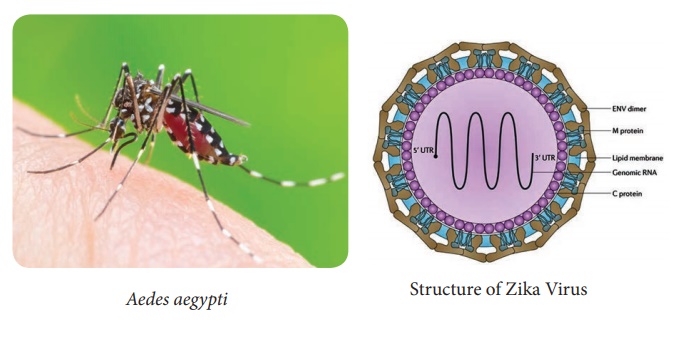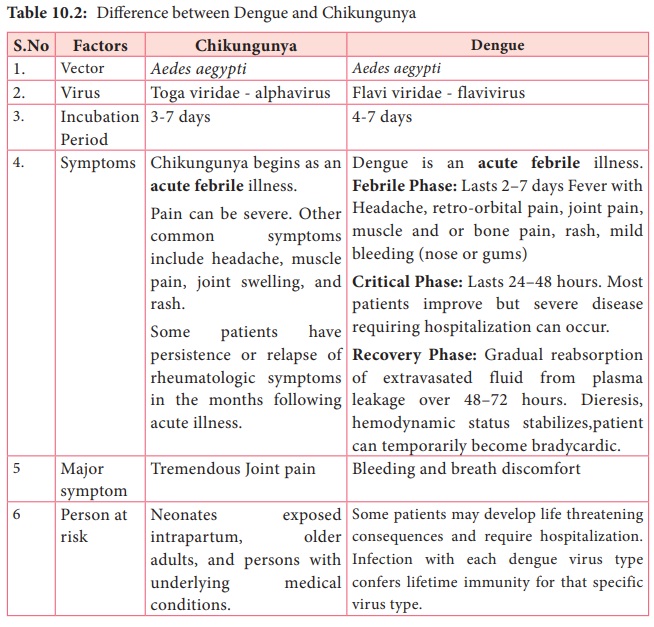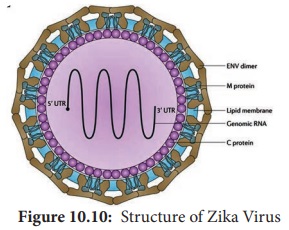Toga Viruses, Zika Virus - Arbo Virus | 12th Microbiology : Chapter 10 : Medical Virology
Chapter: 12th Microbiology : Chapter 10 : Medical Virology
Arbo Virus

Arbo Virus
Arbo
Viruses (arthropod - borne viruses) are viruses of vertebrates biologically
transmitted by hematophagous insect vectors. They multiply in blood sucking insects and are transmitted by bite to
vertebrate hosts. Arbo viruses are worldwide in distribution. Arbo viruses have
been named according to the disease caused (yellow fever), the place of isolation of the virus (kyasanur forest disease) or the local name for the disease (chikungunya). They are
classified into Toga, Flavi, Bunya, Reo and Rhabdovirus families. Arbo viruses
have a very wide host range including many species of animals and birds. The
most important arbo virus vectors are mosquitoes,
followed by ticks.
The virus
enters the body through the bite of
the insect vector. After multiplication in
the reticuloendothelial system, viremia
of varying duration occurs, or the virus is transported to the target organs such as central nervous system
in encephalitis, the liver in yellow fever and the capillary
endothelium in hermorrhagic fever.
Clinical
syndromes are fever with or without rash, encephalitis, hemorrhagic fever,
systemic disease and yellow fever.
Diagnosis
may be established by virus isolation or serology.
Samples
(Blood, CSF) are inoculated intra cerebrally into sucking mice. The animal
develop fatal encephalitis. Viruses
may be isolated in tissue cultures or in eggs. Isolates are identified by
hemagglutination inhibition, complement fixation, gel precipitation,
immunofluorescence and ELISA. Virus isolated from insect vectors and from
reservoir animal.
Toga Viruses
Toga
viruses are spherical enveloped viruses with a diameter of 50-70nm
Single stranded RNA genome. The virus replicates in the cyloplasm of the host cell and released by budding through host
cell membranes. The name Toga Virus is derived from ‘toga’ meaning the Roman Mantle refers to the viral envelope.
The genus
Alpha Virus was formerly classified as Group
A arbo viruses which explains the name Alpha Virus. The genus Alpha Virus
contains 32 species of which 13 infect humans. All are mosquito borne.
1. Chikungunya Virus
The virus
was first isolated from human patients of Aedes aegypti mosquitoes (Figure
10.9) from Tanzania in 1952. The name Chikungunya is derived from the native
word for the disease in which the patient lies ‘doubled up due to severe joint
pains’. The virus first appeared in India
in 1963 in Calcutta, Madras and Other areas.

The
disease presents as a sudden onset of fever, Crippling joint pains,
lymphadenopathy and conjunctivitis. A maculopapular
rash in common. The fever is
typically biphasic with a period of remission after 1–6 days of fever. The
vector is Aedes aegypti . No animal reservoir has been identified.
Antibody to the virus has been demonstrated in horses, cattle and other
domestic animals.
Flavi viruses
The family flaviviridae contains only one genus flavivirus. They are smaller than alpha viruses, being 40nm in diameter. There are over 60 arthropod borne flava viruses classified as mosquito-borne and tick borne viruses. Examples of mosquito borne group known as encephalitis viruses they are St. Louis encephalitis Virus, Ilheus virus, west nile virus, murray valley encephalitis virus and Japanese encephalitis. Tick borne viruses are classified in to tick borne encephalitis viruses and tick borne hemorrhagic fevers
2. Dengue
The name
dengue is derived from the ‘Swahili ki
denga pepo’, meaning a sudden seizure by a demon. Dengue fever is
similar to the illness caused by chikungunya. Four types of dengue virus exist:
DEN1, DEN2, DEN3 and DEN4.
HOTS: What is the best home remedy for dengue fever?
Dengue
presents after an incubation period of 3 -14 days as fever of sudden onset with
headache, retrobulbarpain, conjunctival injection, pain in the back and limbs
(break bone fever), lymphadenopathy and maculopapular rash. The fever is
typically biphasic (saddle back) and
lasts for 5–7 days. Dengue may be more serious forms with hemorrhagic manifestations (dengue Hemorrhagic fever) or with shock
(dengue shock syndrome).
Dengue
virus is transmitted from person to person by Aedes aegypti mosquitoes.
The Incubation period is 8–10days. All four types of dengue virus are
identified. Demonstration of circulating IgM antibody provides early diagnosis.
IgM ELISA test offers reliable diagnosis. Difference between Dengue and
Chikungunya is given in Table 10.2.

Zika Virus
Zika
virus is a mosquito-borne flavivirus that was identified in Uganda in 1947 in monkeys. Zika spreads by daytime-active Aedes mosquitoes, such as A. aegypti and A. albopictus. The infection is known as Zika fever or Zika virus disease . Zika is related to the dengue, yellow
fever, Japanese encephalitis, and West Nile viruses
Zika virus
is enveloped and icosahedral and has a non segmented, single-stranded, positive-sense (+) RNA genome (Figure 10.10). A positive-sense RNA genome can be directly translated into viral proteins, the RNA genome encodes seven nonstructural proteins and three structural proteins. One of the structural proteins forms the
envelope. The RNA genome forms a nucleocapsid along with copies of the 12-kDa
capsid protein.

Viral genome replication depends on the making of double- stranded RNA from the single-stranded, positive-sense RNA (ssRNA(+)) genome followed by transcription and replication to provide viral mRNAs and new ssRNA(+) genomes.
Pathogenesis and Clinical features
Zika
virus replicates in the mosquito’s mid
gut epithelial cells and then its
salivary gland cells. After 5–10
days, the virus can be found in the mosquito’s saliva. If the mosquito’s saliva
is inoculated into human skin, the
virus can infect epidermal keratinocytes, skin fibroblasts in the skin and the
Langerhans cells. The pathogenesis of the virus is hypothesized to continue
with a spread to lymph nodes and the bloodstream.
Zika virus is primarily transmitted by the bite of an infected mosquito from the Aedes genus, mainly Aedes aegypti. The mosquitoes usually bite during the day, peaking
during early morning and late afternoon or evening. This is the same mosquito
that transmits dengue, chikungunya and yellow fever. Zika virus is also
transmitted from mother to fetus during pregnancy, through sexual contact,
transfusion of blood and blood products, and organ transplantation.
The incubation period of Zika virus disease is estimated to be 3–14 days . The majority of people infected with Zika virus do not develop symptoms. Symptoms are generally mild including fever, rash, conjunctivitis, muscle and joint pain, malaise, and headache, and usually last for 2–7 days. Zika fever (also known as Zika virus disease) is an illness caused by the Zika virus. Zika virus infection during pregnancy is a cause of microcephaly and other congenital abnormalities in the developing fetus and newborn. Zika infection in pregnancy also results in pregnancy complications such as fetal loss, stillbirth, and preterm birth.
Infobits
Which fruit is good to increase
platelet count?
Pomegranate is another great fruit you
can eat to increase platelets. As with all redfruits,
the seeds of this deliciousfruit are
packed with iron, an essential
mineral for combating low platelet count. Pomegranate
has been used since the ancient times for its healthy and medicinal properties.
Laboratory diagnosis
Virus can
be demonstrated from the blood or other body fluids, such as urine or semen.
Zika
virus grow well in a variety of mammalian and insect cell lines. Zika virus is
identified by NAAT− Nucleic acid Amplification
test, Zika Antigen is detected by ELISA and PCR. Zika Antibody IgM is
detected by MAC - ELISA, IgG by
ELISA and by PRNT-plaque reduction
neutralization test.
Prevention and Treatment
Protection
against mosquito bites during the
day and early evening is a key measure to prevent Zika virus infection. It is
important to eliminate these mosquito breeding sites, Health authorities may
also advise use of larvicides and
insecticides to reduce mosquito populations and disease spread. There is no
treatment available for Zika virus infection or its associated diseases. No vaccine is yet available for the prevention or treatment of Zika virus infection.
Development of a Zika vaccine remains an active area of research.
Related Topics